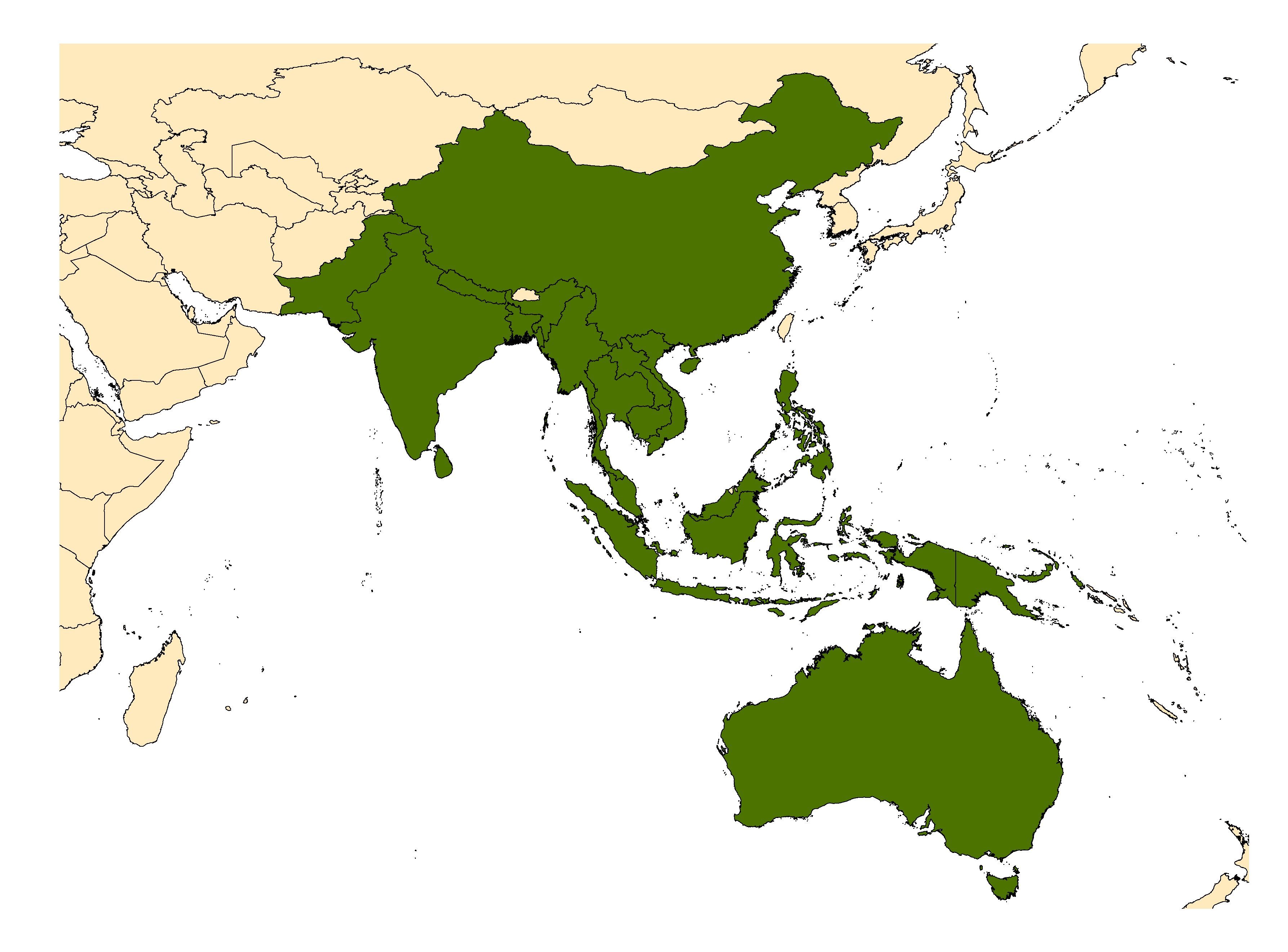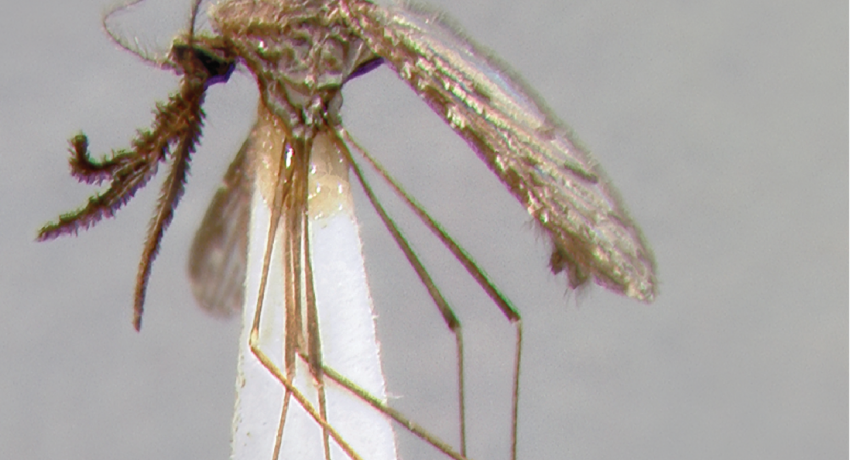INDOMALAYAN, ORIENTAL & AUSTRALASIAN REGIONS
Etymology: n.s. [bearded beak (L) - proboscis and palpi with many erect scales]
A recent series of integrated molecular and morphological studies have formally recognized six taxa in the Barbirostris Complex, stabilizing the internal systematics of the complex. This taxonomic assessment was further complicated by the discovery of two isomorphic An. barbirostris s.l. species at the type locality in Mount Ardjoeno in Java. Along with An. barbirostris s.s., members of the Barbirostris Complex now include An. campestris Reid, An. dissidens Taai & Harbach, An. saeungae Taai & Harbach, An. vanderwulpi Townson & Harbach, and An. wejchoochotei Taai & Harbach. Another cryptic taxon (An. barbirostris species A3) is reported in Kanchanaburi, Thailand, and at least one more is suspected in Sulawesi. To date, nuclear ITS2 rDNA and mtDNA COI sequences generated from An. barbirostris s.l. specimens collected from Kalimantan do not match any other recognized Barbirostris Group species.
Although Anopheles barbirostris s.l. is reported from the India to Borneo, An. barbirostris s.s. has only been molecularly confirmed in Borneo (Kalimantan), Java, Thailand and Vietnam to date. Further molecular studies are needed to confirm the distributions of all component taxa.
Type locality: Mount Ardjoeno, Java [Indonesia]
Type depository: State Museum of Natural History, Leyden, Netherlands (LM)
DIAGNOSTIC CHARACTERS (Click photos to view; mouse over and click large photo to zoom in.)
ADULT (illustrated): Head: Proboscis entirely dark-scaled; palpus with dark, numerous and erect scales; pedicel with dorsal and lateral scales; clypeus without scales. Thorax: Antepronotal scales present (not distinct in photo); pleuron with white scale patches. Abdomen: Sterna with median patches of pale scales and rows of pale scales on lateral margins; VII-S with a tuft of dark scales. Legs: Fe-III mostly dark, without preapical pale band; Ta-II1–5 not banded. Wing: With three large dark spots on costa (C) and veins R–R1; costa lacking a presector pale spot; apex with two small fringe spots.
LARVA (not illustrated): Head: Seta 1-A well-developed, long; seta 3-C usually with 40+ stiff branches. Thorax: Seta 1-P well-developed. Seta 1-I well-developed palmate; seta 1 well-developed palmate on ≥5 segments.
TAXONOMIC KEYS
Nguyen Thuong Hien 1968 (Vietnam)
Rattanarithikul & Harrison 1973 (Thailand)
Lee et al. 1987b: 39 (Australasia)
Darsie & Pradhan 1990, 1991 (Nepal)
Rattanarithikul et al. 2006b (Thailand)
![]()
WRBU - Anopheles – Myzorhynchus – Indomalayan - Adult
![]()
WRBU - Anopheles – Myzorhynchus – Indomalayan - Larvae
![]()
WRBU - Anopheles – Myzorhynchus – Oriental Region – Adult
![]()
WRBU - Anopheles – Myzorhynchus – Oriental Region – Larvae
![]()
WRBU - Genera - Global - Adult
![]()
WRBU - Genera - Global - Larva
Exemplar DNA sequences
An. barbirostris ITS2: EU812764 (Thailand), EU812759 (Kalimantan); COI: AB971312 (Thailand)
An. barbirostris species A3 ITS2: U60410, AB362232–34; COI: AB32238–40 (Thailand)
An. dissidens ITS2: AB971284–96, EU812769, EU812781(Thailand); COI: AB971313–25 (Indonesia)
An. saeungaeITS2: AB971297–305, EU812795, EU812791 (Thailand); COI AB971326–34 (Thailand)
An. vanderwulpi ITS2: EU812766–68 (Sumatra)
(For An. campestris and An. wejchoochotei, see /vectorspecies/mosquitoes/campestris.)
BIONOMICS
Immatures
Typically, An. barbirostris s.l. is found in almost all stagnant groundwater pools, wells, drainage ditches and animal footprints, as well as at the margins of flowing rivers and streams Habitats are usually in open sunlight or partial shade, with some vegetation.
Adults
Anopheles barbirostris s.l. are often found in hill and foothill environments, particularly in rice-growing areas. Anopheles. barbirostris s.s. have been collected resting inside human dwellings and animal shelters, and although the species mainly feeds on large mammals, including cows and horses, it will feed on man where their preferred hosts are scarce. The biomedical importance of each complex member remains unclear, thus the associated pathogens listed below refer to An. barbirostris s.l.
DISTRIBUTION NOTES
An. barbirostris s.s. : Borneo (Kalimantan), Java, Thailand and Vietnam
An. barbirostris s.l. : Australia, Bangladesh, Cambodia, Guam, India (includes Andaman Islands), Indonesia (includes Borneo, Java, Flores, Moluccas, Sulawesi, Sumatra (includes Keulauan Riouw Archipelago, Timor), Laos, Malaysia, Myanmar, Nepal, Papua New Guinea, Pakistan, People's Republic of China (includes Hainan), Philippines, Sri Lanka, Thailand, Vietnam.

WRBU VECTOR HAZARD REPORTS
None; View other WRBU Vector Hazard Reports
Available GIS Models:
An.barbirostris_s.l._Foley_1: Oriental Region
An.barbirostris_Nyari_1: Oriental Region
IMPORTANT REFERENCES (full citations below)
van der Wulp 1884: 248 (F)
Davis 1926 (F*)
Christophers 1933: 155 (M*, F*, P, L, E)
Penn 1949b: 12 (P*)
Bonne-Wepster & Swellengrebel 1953: 201 (M*, F*, L*)
Reid 1962: 7 (M, F*, P*, L, E*)
Nguyen Thuong Hien 1968 (F*, L*; keys, taxonomy, bionomics, Vietnam)
Reid 1968: 122 (M*, F*, P*, L*, E*)
Chowdaiah et al. 1970 (chromosomes*)
Aslamkhan 1971b (distr. Pakistan) Ameen & Talukdar 1974c: 92 (P*)
Harrison & Scanlon 1975: 83 (M*, F*, P*, L*; distribution)
Rattanarithikul & Harrison 1973 (L*; key, distribution; Thailand, as s.l.)
Lien et al. 1977 (taxonomy)
Lee et al. 1987b: 39 (F; key, taxonomy, bionomics, distribution, review)
Darsie & Pradhan 1990 (F, L; tax., keys, bionomics, distribution; Nepal)
Whelan & Hapgood 2000 (bionomics, distribution; East Timor)
Oo et al. 2004 (distribution; Myanmar)
Rattanarithikul et al. 2006b (F*, L*; bionomics, distribution, keys)
Sinka et al. 2011: 89 (Barbirostris Complex bionomics, review, distribution, niche model)
Taai & Harbach 2015: 245 (M*, F*, P*, L*; phylogeny, redescription, bionomics)
CURRENT SYNONYMS
syn. martini Laveran
1902a: 907 (F). Type locality: Near Pursat, Cambodia, Indochina (PIP). References: Reid 1947: 89 (synonymy).
syn. innominata Stoker & Waktoedi Koesoemawinangoen
1949: 10 (A* barbirostris ssp.). Type locality: Celebes [Sulawesi] (LU). References: Bonne-Wepster & Swellengrebel 1953: 209 (as syn. of vanus) Reid 1968: 122 (synonymy).
CITED REFERENCES
Ameen, M.-U., & Talukdar, M.Z.I. (1974c). Pupal chaetotaxy of the common mosquitoes of Dacca. Beiträge zur Entomologie, 24(1,4), 87–95.
Aslamkhan, M. (1971b). The mosquitoes of Pakistan I. A checklist. Mosquito Systematics, 3(4), 147–159.
Bonne-Wepster, J., & Swellengrebel, N.H. (1953). The anopheline mosquitoes of the Indo-Australian Region. Amsterdam: J. H. de Bussy.
Chowdaiah, B.N., Avirachan, T.T., & Seetharam, P.L. (1970). Chromosome studies of oriental anophelines. I. The salivary gland chromosomes of Anopheles barbirostris. Experientia, 26, 315–317.
Christophers, S.R. (1933). The fauna of British India, including Ceylon and Burma. Diptera. Vol. IV. Family Culicidae. Tribe Anophelini. London: Taylor and Francis.
Darsie, R.F., Jr., & Pradhan, S.P. (1990). The mosquitoes of Nepal: Their identification, distribution and biology. Mosquito Systematics, 22(2), 69–130.
Davis, N.C. (1926). Notes on the female hypopygia of anopheline mosquitoes, with special reference to some Brazilian species. American Journal of Hygiene, 6, 1–22.
Harrison, B.A., & Scanlon, J.E. (1975). Medical entomology studies-II. The subgenus Anopheles in Thailand (Diptera: Culicidae). Contributions of the American Entomological Institute, 12(1), iv + 1–307.
Laveran, A. (1902a). Sur des culicides du Cambodge. Comptes Rendus Société de Biologie, 54, 906–908.
Lee, D.J., Hicks, M.M., Griffiths, M., Debenham, M.L., Bryan, J.H., Russell, R.C., . . . Marks, E.N. (1987b). The Culicidae of the Australasian region. Volume 5. Commonwealth Department of Health, School of Public Health and Tropical Medicine Monograph Series, 2.
Lien, J.C., Kawengian, B.A., Partono, F., Lami, B., and Cross J.H. (1977). A brief survey of the mosquitoes of South Sulawesi, Indonesia, with special reference to the identity of Anopheles barbirostris (Diptera: Culicidae) from the Margolembo area. Journal of Medical Entomology, 13(6), 719–727.
Nguyen Thuong Hien 1968. The genus of Anopheles in Vietnam. Saigon: Bureau of Entomology, National Malaria Program/ Republic of Vietnam. English translation by Military Entomology Information Service. 205pp.
Oo, T.T., Storch, V., & Becker, N. (2004). Review of the Anopheles mosquitoes of Myanmar. Journal of Vector Ecology, 29(1), 21–40.
Penn, G.H. (1949a). Pupae of the Nearctic anopheline mosquitoes north of Mexico. Journal of the National Malaria Society, 8, 50–69.
Rattanarithikul, R., & Harrison, B.A. (1973). An illustrated key to the Anopheles larvae of Thailand. U S Army Medical Component, SEATO, Bangkok, Thailand.
Rattanarithikul, R., Harrison, B.A., Harbach, R.E., Panthusiri, P., & Coleman, R.E. (2006b). Illustrated keys to the mosquitoes of Thailand. IV. Anopheles. Southeast Asian Journal of Tropical Medicine and Public Health, 128(Supplement 2), 2.
Reid, J.A. (1947). Type specimens of Culicidae described by Laveran (Diptera: Culicidae). Proceedings of the Royal Entomological Society (B), 16, 86–91.
Reid, J.A. (1962). The Anopheles barbirostris group (Diptera, Culicidae). Bulletin of Entomological Research, 53, 1–57.
Reid, J.A. (1968). Anopheline mosquitoes of Malaya and Borneo. Studies from the Institute for Medical Research Malaysia, 31, 1–520.
Sinka, M.E., Bangs, M.J., Manguin, S., Chareonviriyaphap, T., Patil, A.P., Temperley, W.H., ... Hay, S.I. (2011). The dominant Anopheles vectors of human malaria in the Asia-Pacific region: Occurrence data, distribution maps and bionomic précis. Parasites & Vectors, 4(1), 89.
Stoker, W. J., & Waktoedi Koesoemawinangoen, R. (1949). Illustrated map of the anopheline imagines of Indonesia (English trans.): Ministry of Health, Djakarta.
Taai, K., & Harbach, R.E. (2015). Systematics of the Anopheles barbirostris species complex (Diptera: Culicidae: Anophelinae) in Thailand. Zoological Journal of the Linnean Society, 174(2), 244–264.
van der Wulp, F.M. (1884). Note XXXVIII. On exotic Diptera. Part 1. Notes from the Leyden Museum, 6, 248–>256.
Whelan, P., & Hapgood, G. (2000). A mosquito survey of Dili, East Timor, and implications for disease control. Arbovirus Research in Australia, 8, 405–416.
CITE THIS PAGE
Walter Reed Biosystematics Unit (Year). Anopheles barbirostris species page. Walter Reed Biosystematics Unit Website, http://wrbu.si.edu/vectorspecies/mosquitoes/barbirostris, accessed on [date (e.g. 03 February 2020) when you last viewed the site].










































































































































































